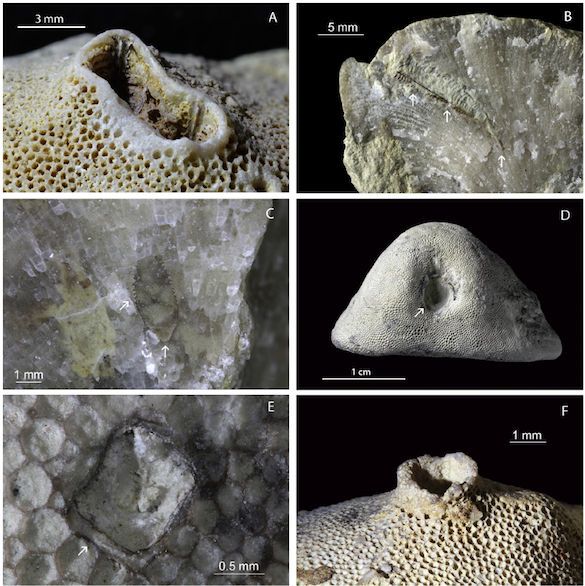A new paper is just out in which all the characters have been covered previously in this blog, but not as parts of a single story. It describes an interprets the relationship between the mysterious conulariids and trepostome bryozoans in the Katian and Sandbian (Upper Ordovician) of northern Estonia. The authors have all made appearance here, including lead author Olev Vinn (Institute of Ecology and Earth Sciences, University of Tartu, Estonia). Andrej Ernst (Institut für Geologie, Universität Hamburg, Germany), myself, and Ursula Toom (Institute of Geology, Tallinn University of Technology, Estonia). It was a fun team to work on, and Olev led it masterfully.
There are numerous trepostome bryozoans in the Upper Ordovician of Estonia that grew up and around the bases of conulariids, which are extinct cnidarians. This is, in fact, an example of bryoimmuration as covered in my last post. The puzzle is what was the relationship between these two groups. Were the conulariids parasites on the bryozoans? Did they gain protection from predators by embedment in the bryozoan calcitic skeleton? Were the bryozoans prime real estate for the conulariids because they were hard substrate islands on a muddy seafloor? We think the answers are probably yes to all these questions.
The top composite of images is Figure 3 in the paper. The caption: A, Two conulariids Climacoconus bottnicus (Holm, 1893) in Diplotrypa bicornis (Eichwald, 1829) from Haljala Regional Stage, northern Estonia, note the slightly elevated apertures of conulariids (GIT 720-4). B, Longitudinal section of Diplotrypa abnormis (Modzalevskaya, 1953) with conulariid Climacoconus bottnicus (Holm, 1893) (GIT 537-1822) from Haljala Regional Stage, northern Estonia. C, Longitudinal section of completely embedded Climacoconus bottnicus (Holm, 1893) in Esthoniopora communis (GIT 537-1656) from Haljala Regional Stage, northern Estonia. D, Conulariid in Mesotrypa expressa Bassler, 1911 from Oandu Regional Stage, northern Estonia; note the depression around the conulariid’s aperture (GIT 770-7). E, Conulariid in Mesotrypa expressa Bassler, 1911 from Oandu regional Stage, northern Estonia; note the malformation of a zooid near the aperture of the conulariid (GIT 770-92). F, Conulariid in Esthoniopora subsphaerica from Rakvere Regional Stage, northern Estonia; note the strongly elevated aperture of the conulariid (GIT 537-1760).
This work is another product of Wooster’s generous research leaves program that has supported many trips to Estonia.
Reference:
Vinn, O., Ernst, A., Wilson, M.A., and Toom, U. 2019. Symbiosis of conulariids with trepostome bryozoans in the Upper Ordovician of Estonia (Baltica). Palaeogeography, Palaeoclimatology, Palaeoecology 518: 89-96.



